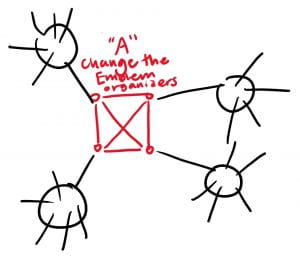Tracking Diffusion in a Local Political Movement
In July of 2020, I was added to a private Facebook group titled “Change the Arcadia High Emblem.” In the midst of several social movements in a COVID-19 era, my high school network consisting of students, alumni, and faculty, also decided to raise awareness about a local issue in my hometown of Arcadia, California. This Facebook group consisted of people who held the sentiment that our high school emblem, the Apache, was highly offensive, and worked to sway the administration to change it.
Though we were ultimately unable to sway the administration to change the Apache into another mascot, the movement was able to convince some campus groups to adopt the agenda. Because the high school emblem is the Apache, several campus groups such as the newspaper and the news show, are named “Apache Pow-wow” and “Apache News” respectively. These student organizations are presumably in the works of removing Apache-related terminology in their names. This adoption of the political opinion to change the Apache emblem by the student organizations, and the inability of it to spread to the administration, is an example of the diffusion of innovations.
The diffusion of innovations is the process that describes how new behaviors and opinions are introduced to a social network, and how people influence their friends to adopt those behaviors and opinions. With this local social movement, the opinion that the Apache emblem needed to be replaced at this time began with a small group of people who began the Facebook group. These people held strong opinions and were well-informed about the matter. This group of people can be considered a tight-knit cluster with strong ties, labeled group A in the diagram below.
These people in group A eventually added people whom they believe would support the movement, such as close friends, family, or former classmates. Additionally, each of the new people that were added also had their own social networks and friend groups to spread awareness of the cause and As a result, the Facebook group has over 1,100 members today—out of those 1,100+, I have only 90 mutual Facebook friends. Some of these Facebook group members consist of people that belong in and have influence over campus organizations. Therefore, someone who holds a leadership position in a club at Arcadia High School who has adopted this behavior influences their fellow club leaders. If that person is able to successfully influence them to also adopt their behavior, then as leaders, they have the power to enforce that behavior to the rest of the club. For example, the editors in the school newspaper, the Apache Pow-Wow, in support of the movement to change the emblem, allegedly made the executive decision to change the club name, influencing this whole cluster of newspaper members to contribute to the movement. After one cluster fully adapts the behavior, other connected clusters can also follow suit, as depicted below.
If one club chooses to reform their organization to support “Change the Emblem”, this behavior diffuses to clubs that that club is tied to. In the Arcadia High School network, it may have started with the newspaper and then spread to an organization with a similar purpose, such as the news show (Apache News).
As mentioned above, the movement was unable to influence the high school itself to change the Apache emblem. This diffusion stopped because the opposition to adopt this change existed in an extremely dense cluster, the high school administration. If students were more likely to support the change, and the faculty were not, it is highly unlikely for the faculty to be influenced by the students because these two groups are highly dense clusters with weak ties to each other. Additionally, the administration has much greater power over the student body. Even if all the student body is in support of changing the emblem, the administration does not have much incentive to do so.
What exists now in the aftermath of the movement is coexistence between the clubs who chose to chose to change their club names, the clubs who did not, and the administration. For now, this is the natural boundary between the two opposing opinions.
Though the movement has since died down, if you are in support of the cause to “Change the Emblem,” you can donate directly to the White Mountain Apaches below and sign the petition to the high school.
https://www.change.org/p/david-vannasdall-remove-the-apache-emblem-from-arcadia-high-school


